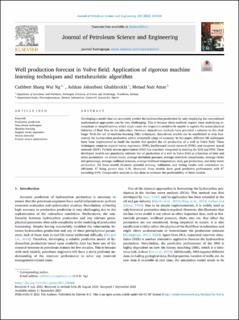| dc.contributor.author | Ng, Cuthbert Shang Wui | |
| dc.contributor.author | Jahanbani Ghahfarokhi, Ashkan | |
| dc.contributor.author | Nait Amar, Menad | |
| dc.date.accessioned | 2022-02-10T14:55:45Z | |
| dc.date.available | 2022-02-10T14:55:45Z | |
| dc.date.created | 2021-09-14T20:49:28Z | |
| dc.date.issued | 2021 | |
| dc.identifier.citation | Journal of Petroleum Science and Engineering. 2021, 208 (B), . | en_US |
| dc.identifier.issn | 0920-4105 | |
| dc.identifier.uri | https://hdl.handle.net/11250/2978309 | |
| dc.description.abstract | Developing a model that can accurately predict the hydrocarbon production by only employing the conventional mathematical approaches can be very challenging. This is because these methods require some underlying assumptions or simplifications, which might cause the respective model to be unable to capture the actual physical behavior of fluid flow in the subsurface. However, data-driven methods have provided a solution to this challenge. With the aid of machine learning (ML) techniques, data-driven models can be established to help forecasting the hydrocarbon production within acceptable range of accuracy. In this paper, different ML techniques have been implemented to build the models that predict the oil production of a well in Volve field. These techniques comprise support vector regression (SVR), feedforward neural network (FNN), and recurrent neural network (RNN). Particle swarm optimization (PSO) has also been integrated in training the SVR and FNN. These developed models can practically estimate the oil production of a well in Volve field as a function of time and other parameters: on stream hours, average downhole pressure, average downhole temperature, average choke size percentage, average wellhead pressure, average wellhead temperature, daily gas production, and daily water production. All these models illustrate splendid training, validation, and testing results with correlation coefficients, R2 being greater than 0.98. Moreover, these models show good predictive performance with R2 exceeding 0.94. Comparative analysis is also done to evaluate the predictability of these models. | en_US |
| dc.language.iso | eng | en_US |
| dc.publisher | Elsevier | en_US |
| dc.rights | Navngivelse 4.0 Internasjonal | * |
| dc.rights.uri | http://creativecommons.org/licenses/by/4.0/deed.no | * |
| dc.title | Well production forecast in Volve field: Application of rigorous machine learning techniques and metaheuristic algorithm | en_US |
| dc.type | Peer reviewed | en_US |
| dc.type | Journal article | en_US |
| dc.description.version | publishedVersion | en_US |
| dc.source.pagenumber | 13 | en_US |
| dc.source.volume | 208 | en_US |
| dc.source.journal | Journal of Petroleum Science and Engineering | en_US |
| dc.source.issue | B | en_US |
| dc.identifier.doi | 10.1016/j.petrol.2021.109468 | |
| dc.identifier.cristin | 1934338 | |
| cristin.ispublished | true | |
| cristin.fulltext | original | |
| cristin.qualitycode | 2 | |

